Relationship between IT Self-Efficacy and Personal Knowledge and Information Management for Sustainable Lifelong Learning and Organizational Performance: A Systematic Review from 2000 to 2022
Abstract
1. Introduction
1.1. Statement of Problem with Rationale and Significance
1.2. Objectives
- To identify the relationship between IT self-efficacy and personal knowledge and information management practices.
- To investigate trending tools and approaches being applied for personal knowledge and information management for sustainable lifelong learning and organizational performance.
- To reveal challenges for the development of an effective personal knowledge and information management system.
2. Literature Gaps
3. Materials and Methods
3.1. Stage 1: Planning
3.1.1. Research Objectives
3.1.2. Search Strategy
- a.
- Search terms
- Employment of variables from the title of the paper as a major strategy to search for required literature
- Selection of keywords from the study’s objectives
- Usage of the key terms applied by other researchers in their articles
- Use of Boolean operators “OR”, “AND”, “NOT” for finding specific results
- b.
- Use of literature resources and existing research
3.2. Stage 2: Selection
Search Process
3.3. Stage 3: Extraction
3.4. Stage 4: Execution
4. Results
4.1. An overview of the Selected Studies
4.2. Geographical Distribution of the Studies
4.3. History and Timeline
4.4. Research Methods Used in the Previous Studies
4.5. Relationship between IT Efficacy and PKIM Practices
4.6. Trending Approaches for PKIM for Sustainable Lifelong Learning and Organizational Performance
4.6.1. Social Media Tools
4.6.2. Psychological Ownership
4.6.3. Adoption of Emerging Technologies
4.6.4. Artificial Intelligence
4.6.5. Collaborative Efforts
4.7. Challenges for Developing an Effective PKIM System
4.7.1. Human Issues
4.7.2. Financial Issues
4.7.3. Technical Issues
5. Discussion
5.1. Relationship between IT Self-Efficacy and PKIM
5.2. Trending Approaches for PKIM
5.3. Challenges for the Development of an Effective PKIM System
5.4. Implications
6. Conclusions
6.1. Recommendations
- Academia–industry linkages need to be promoted. A strong liaison should be developed between academia and industry to promote PKIM courses.
- The critical thinking skills of students and workers should be developed to motivate them towards PKIM practices.
- There should be a work–life balance so that proper attention may be paid to knowledge and information-based activities.
- An atmosphere of trust should be created for the psychological ownership of students and workers.
- A course on PKIM needs to be taught at universities, covering all key concepts.
- Expertise in information literacy skills and digital media tools should be developed to turn individuals into skilled assets.
- Adequate funds should be provided for the successful implementation and functioning of PKIM systems.
- Emerging tools need to be implemented for managing information overload and the heterogeneity of the data.
- Faculty members of universities and employers in organizations should spread awareness about the potential benefits of PKIM.
- Higher education bodies should revise their existing curriculum through the inclusion of PKIM courses.
- Librarians should conduct training workshops to provide the required awareness and competencies related to effective PKIM practices.
6.2. Limitations
6.3. Future Research Directions
- The current study has attempted to identify the relationship between IT self-efficacy and PKIM through a systematic literature review. In the future, a study may be conducted to find out the relationship between e-learning self-efficacy and PKIM through an in-depth scoping review.
- Future researchers might include all sources of knowledge, including websites, blogs, grey literature, and books to conduct a systematic literature review on the relationship between IT self-efficacy and PKIM for innovative learning and performance for offering a broader outlook to the readers.
- Future investigators may conduct an empirical study using quantitative, qualitative, mixed methods, and experimental methodologies to find out the relationship between IT self-efficacy and PKIM for sustainable lifelong learning and organizational performance.
- Future researchers should use sequential explanatory research methodology to develop a framework for an efficient PKIM system based on the recommendations provided in the current study.
- A quantitative study may also be carried out in the future to test the validity of the key practical solutions offered in the current study.
Author Contributions
Funding
Institutional Review Board Statement
Informed Consent Statement
Data Availability Statement
Acknowledgments
Conflicts of Interest
Appendix A
| S.N. | Author | Year | Country | Journal | Relationship between IT Efficacy and PKIM | Trending Approaches of PKIM for Sustainable Lifelong Learning and Organizational Performance | Challenges for Developing an Effective PKIM System |
|---|---|---|---|---|---|---|---|
| Hwang, et al. [5] | 2015 | USA | European Journal of Information Systems | IT self-efficacy is positively correlated with personal knowledge and information management. |
| |
| Zi, et al. [11] | 2020 | Taiwan | Information Processing and Management | Social media platforms | ||
| Shao, et al. [27] | 2015 | China | Industrial Management & Data Systems | Computer self-efficacy is closely connected with PKIM. | ||
| Chien [28] | 2012 | USA | European Journal of Training and Development | Learners’ computer self-efficacy has a positive effect on the effectiveness of PKIM for learning and job efficiency. | ||
| Shah and Mahmood [31] | 2013 | Pakistan | Library Management |
| ||
| Akbari and Ghaffari [32] | 2017 | Iran | Journal of Knowledge Management |
| ||
| Agnihotri and Troutt [26] | 2008 | USA | Online Information Review | Skills tools have a strong relation with personal knowledge and information management practices. | Unavailability of personal knowledge and information management trends in academia and industry | |
| Lai [35] | 2008 | Taiwan | Journal of the American Society for Information Science and Technology | IT self-efficacy leads towards effective personal information management and innovative work output. | Unavailability of advanced technologies to implement knowledge management systems | |
| Saleem, et al. [3] | 2021 | Pakistan | Malaysian Journal of Library & Information Science | Information literacy skills | ||
| Swigon [4] | 2013 | Poland | Journal of Information Science |
| ||
| Pucihar, et al. [39] | 2016 | Slovenia | Aslib Journal of Information Management |
| ||
| Liu, et al. [30] | 2017 | Taiwan | Journal of Knowledge Management | Computer usage efficiency leads towards efficient personal knowledge and information management. | Big data | Vast amount of scattered information |
| Razmerita, et al. [12] | 2009 | Denmark | Online Information Review | Web self-efficacy and tools have a strong impact upon personal knowledge management. |
|
|
| Jarrahi, et al. [15] | 2020 | USA | Information and Learning Sciences | Digital self-efficacy has a significant positive relation with personal knowledge and information management and increased learning and work productivity. |
| |
| Jafari, et al. [29] | 2013 | Iran | Education, Business and Society: Contemporary Middle Eastern Issues |
|
| |
| Vark and Reino [16] | 2020 | Estonia | Journal of Documentation | IT efficacy and personal knowledge and information management are interconnected and productive for supporting learning and work output. | Usage of the latest technologies | Traditional approaches |
| Carneiro [25] | 2000 | Portugal | Journal of Knowledge Management |
| ||
| Zhang, et al. [34] | 2008 | USA | Online Information Review |
| ||
| Chatti [17] | 2012 | Germany | Journal of Knowledge Management |
|
| |
| Jefferson [38] | 2006 | USA | VINE: The Journal of Information and Knowledge Management Systems |
|
| |
| Shujahat, et al. [37] | 2021 | China | Journal of Knowledge Management |
| ||
| Masood, et al. [53] | 2022 | China | Journal of Knowledge Management | There is a positive association between social media efficacy and personal knowledge and information management practices. |
| |
| Chou, et al. [18] | 2018 | China | Internet Research | Virtual media efficacy supports the organization and management of personal knowledge and information. |
| Lack of new media literacy skills |
| Volkel and Haller [55] | 2008 | Germany | Online Information Review |
| ||
| Fourie [19] | 2011 | South Africa | Library Hi Tech |
| ||
| Dong, et al. [20] | 2015 | Taiwan | Information Technology & People | Digital efficacy is related with efficient knowledge management. |
|
|
| Hicks, et al. [21] | 2006 | USA | Journal of Knowledge Management |
| Restricted access to required information sources | |
| Bhatt [50] | 2001 | USA | Journal of Knowledge Management | IT skills interact positively with personal knowledge and information management activities. |
| |
| Skoka and Kalmanovitchb [56] | 2005 | UK | Information & Management |
|
| |
| Hsu, et al. [52] | 2007 | Taiwan | International Journal of Human Computer Studies | Technology efficacy is positively associated with life-long learning and job efficiency through productive knowledge and information management. |
| |
| Masadeh, et al. [13] | 2016 | Amman | Journal of Enterprise Information Management | Knowledge management through IT efficacy has relationship with performance in higher education. |
| |
| Jiafu, et al. [36] | 2018 | China | Knowledge Management Research & Practice |
|
| |
| Bharadwaj, et al. [14] | 2015 | India | The Journal for Decision Makers | Technology expertise is linked with knowledge management practices. |
| |
| Mavodza and Ngulube [2] | 2012 | Abu Dhabi | SA Journal of Information Management |
| ||
| Yu [6] | 2010 | Taiwan | Computers in Human Behavior |
| ||
| Cabrera, et al. [51] | 2006 | USA | The International Journal of Human Resource Management | IT efficacy is a pertinent determinant of personal knowledge and information management for sustainable lifelong learning and job efficiency. |
|
References
- Pauleen, D.J.; Gorman, G.E. Personal Knowledge Management; Routledge: London, UK, 2016. [Google Scholar] [CrossRef]
- Mavodza, J.; Ngulube, P. Knowledge management practices at an institution of higher learning. SA J. Inf. Manag. 2012, 14, 8. [Google Scholar] [CrossRef]
- Saleem, Q.U.A.; Ameen, K.; Ashiq, M. Personal knowledge and information management practices of life sciences research students in Pakistan. Malays. J. Libr. Inf. Sci. 2021, 26, 107–123. [Google Scholar] [CrossRef]
- Swigon, M.; Weber, K. Managing Knowledge and Information by Students. J. Inf. Knowl. Manag. 2014, 13, 1450030. [Google Scholar] [CrossRef]
- Hwang, Y.; Kettinger, W.J.; Yi, M.Y. Personal information management effectiveness of knowledge workers: Conceptual development and empirical validation. Eur. J. Inf. Syst. 2015, 24, 588–606. [Google Scholar] [CrossRef]
- Yu, T.-K.; Lu, L.-C.; Liu, T.-F. Exploring factors that influence knowledge sharing behavior via weblogs. Comput. Hum. Behav. 2010, 26, 32–41. [Google Scholar] [CrossRef]
- Chen, S.-S.; Chuang, Y.-W.; Chen, P.-Y. Behavioral intention formation in knowledge sharing: Examining the roles of KMS quality, KMS self-efficacy, and organizational climate. Knowledge-Based Syst. 2012, 31, 106–118. [Google Scholar] [CrossRef]
- Panahi, S.; Watson, J.; Partridge, H. Towards tacit knowledge sharing over social web tools. J. Knowl. Manag. 2013, 17, 379–397. [Google Scholar] [CrossRef]
- Birasnav, M. Knowledge management and organizational performance in the service industry: The role of transformational leadership beyond the effects of transactional leadership. J. Bus. Res. 2014, 67, 1622–1629. [Google Scholar] [CrossRef]
- Gurrin, C.; Smeaton, A.F.; Doherty, A.R. LifeLogging: Personal Big Data. Found. Trends Inf. Retr. 2014, 8, 1–125. [Google Scholar] [CrossRef]
- Yen, A.-Z.; Huang, H.-H.; Chen, H.-H. Multimodal joint learning for personal knowledge base construction from Twitter-based lifelogs. Inf. Process. Manag. 2020, 57, 102148. [Google Scholar] [CrossRef]
- Razmerita, L.; Kirchner, K.; Sudzina, F. Personal knowledge management. Online Inf. Rev. 2009, 33, 1021–1039. [Google Scholar] [CrossRef]
- Masa’Deh, R.; Shannak, R.; Maqableh, M.; Tarhini, A. The impact of knowledge management on job performance in higher education. J. Enterp. Inf. Manag. 2017, 30, 244–262. [Google Scholar] [CrossRef]
- Bharadwaj, S.S.; Chauhan, S.; Raman, A. Impact of Knowledge Management Capabilities on Knowledge Management Effectiveness in Indian Organizations. Vikalpa J. Decis. Mak. 2015, 40, 421–434. [Google Scholar] [CrossRef]
- Jarrahi, M.H.; Reynolds, R.; Eshraghi, A. Personal knowledge management and enactment of personal knowledge infrastructures as shadow IT. Inf. Learn. Sci. 2020, 122, 17–44. [Google Scholar] [CrossRef]
- Värk, A.; Reino, A. Practice ecology of knowledge management—Connecting the formal, informal and personal. J. Doc. 2020, 77, 163–180. [Google Scholar] [CrossRef]
- Chatti, M.A. Knowledge management: A personal knowledge network perspective. J. Knowl. Manag. 2012, 16, 829–844. [Google Scholar] [CrossRef]
- Chou, S.-W.; Hsu, C.-S.; Shiau, J.-Y.; Huang, M.-K.; Chou, Y. Understanding knowledge management phenomena in virtual communities from a goal-directed approach. Internet Res. 2018, 28, 652–674. [Google Scholar] [CrossRef]
- Fourie, I. Personal information management (PIM), reference management and mind maps: The way to creative librarians? Libr. Hi Tech 2011, 29, 764–771. [Google Scholar] [CrossRef]
- Dong, T.-P.; Hung, C.-L.; Cheng, N.-C. Enhancing knowledge sharing intention through the satisfactory context of continual service of knowledge management systems. Inf. Technol. People 2015, 29, 807–829. [Google Scholar] [CrossRef]
- Hicks, R.C.; Dattero, R.; Galup, S.D. The five-tier knowledge management hierarchy. J. Knowl. Manag. 2006, 10, 19–31. [Google Scholar] [CrossRef]
- Ali, I.; Warraich, N.F. Personal information management through ubiquitous devices: Students’ mobile self-efficacy and PIM practices. J. Libr. Inf. Sci. 2021, 54, 174–187. [Google Scholar] [CrossRef]
- Janssen, H.; Singh, J. Personal Information Management Systems. Internet Policy Rev. 2022, 11, 1–6. [Google Scholar] [CrossRef]
- Haider, U.; Batool, S.H.; Malik, A.; Mahmood, K.; Safdar, M. Bonding between information literacy and personal information management practices: A survey of electronic media journalists. Inf. Learn. Sci. 2022, 123, 298–316. [Google Scholar] [CrossRef]
- Carneiro, A. How does knowledge management influence innovation and competitiveness? J. Knowl. Manag. 2000, 4, 87–98. [Google Scholar] [CrossRef]
- Agnihotri, R.; Troutt, M.D. The effective use of technology in personal knowledge management. Online Inf. Rev. 2009, 33, 329–342. [Google Scholar] [CrossRef]
- Shao, Z.; Wang, T.; Feng, Y. Impact of organizational culture and computer self-efficacy on knowledge sharing. Ind. Manag. Data Syst. 2015, 115, 590–611. [Google Scholar] [CrossRef]
- Chien, T. Computer self-efficacy and factors influencing e-learning effectiveness. Eur. J. Train. Dev. 2012, 36, 670–686. [Google Scholar] [CrossRef]
- Jafari, M.; Akhavan, P.; Nikookar, M. Personal knowledge management and organization’s competency: A service organization case study. Educ. Bus. Soc. Contemp. Middle East. Issues 2013, 6, 181–194. [Google Scholar] [CrossRef]
- Liu, C.-H.; Wang, J.S.; Lin, C.-W. The concepts of big data applied in personal knowledge management. J. Knowl. Manag. 2017, 21, 213–230. [Google Scholar] [CrossRef]
- Shah, S.R.; Mahmood, K. Empirical results of academic librarians’ attitudes toward knowledge management in Pakistan. Libr. Manag. 2013, 34, 619–631. [Google Scholar] [CrossRef]
- Akbari, N.; Ghaffari, A. Verifying relationship of knowledge management initiatives and the empowerment of human resources. J. Knowl. Manag. 2017, 21, 1120–1141. [Google Scholar] [CrossRef]
- Ali, I.; Warraich, N.F. The relationship between mobile self-efficacy and mobile-based personal information management practices. Libr. Hi Tech 2020, 39, 126–143. [Google Scholar] [CrossRef]
- Zhang, Z.J. Personalising organisational knowledge and organisationalising personal knowledge. Online Inf. Rev. 2009, 33, 237–256. [Google Scholar] [CrossRef]
- Lai, J.-Y. How reward, computer self-efficacy, and perceived power security affect knowledge management systems success: An empirical investigation in high-tech companies. J. Am. Soc. Inf. Sci. Technol. 2008, 60, 332–347. [Google Scholar] [CrossRef]
- Jiafu, S.; Yu, Y.; Tao, Y. Measuring knowledge diffusion efficiency in R&D networks. Knowl. Manag. Res. Pract. 2018, 16, 208–219. [Google Scholar] [CrossRef]
- Shujahat, M.; Wang, M.; Ali, M.; Bibi, A.; Razzaq, S.; Durst, S. Idiosyncratic job-design practices for cultivating personal knowledge management among knowledge workers in organizations. J. Knowl. Manag. 2021, 25, 770–795. [Google Scholar] [CrossRef]
- Jefferson, T.L. Taking it personally: Personal knowledge management. VINE 2006, 36, 35–37. [Google Scholar] [CrossRef]
- Pucihar, K.C.; Kljun, M.; Mariani, J.; Dix, A.J. An empirical study of long-term personal project information management. Aslib J. Inf. Manag. 2016, 68, 495–522. [Google Scholar] [CrossRef]
- Alon, L.; Nachmias, R. Gaps between actual and ideal personal information management behavior. Comput. Hum. Behav. 2020, 107, 106292. [Google Scholar] [CrossRef]
- Whittaker, S.; Massey, C. Mood and personal information management: How we feel influences how we organize our information. Pers. Ubiquitous Comput. 2020, 24, 695–707. [Google Scholar] [CrossRef]
- Oh, K.E. Social aspects of personal information organization. J. Doc. 2020, 77, 558–575. [Google Scholar] [CrossRef]
- Zhou, W.; Dai, L.; Zhang, Y.; Wen, C. Personal information management on social media from the perspective of platform support: A text analysis based on the Chinese social media platform policy. Online Inf. Rev. 2022, 46, 1–21. [Google Scholar] [CrossRef]
- Nwagwu, W. “Digesting the abundance of idol matter” key factors in personal information management experiences of selected social science faculty. VINE J. Inf. Knowl. Manag. Syst. 2021, 1, 1–23. [Google Scholar] [CrossRef]
- Moher, D.; Shamseer, L.; Clarke, M.; Ghersi, D.; Liberati, A.; Petticrew, M.; Shekelle, P.; Stewart, L.A. Preferred reporting items for systematic review and meta-analysis protocols (PRISMA-P) 2015 statement. Syst. Rev. 2015, 4, 1. [Google Scholar] [CrossRef] [PubMed]
- Liberati, A.; Altman, D.G.; Tetzlaff, J.; Mulrow, C.; Gotzsche, P.C.; Ioannidis, J.P.A.; Clarke, M.; Devereaux, P.J.; Kleijnen, J.; Moher, D. The PRISMA Statement for Reporting Systematic Reviews and Meta-Analyses of Studies That Evaluate Healthcare Interventions: Explanation and Elaboration. BMJ 2009, 339, b2700. [Google Scholar] [CrossRef]
- Mahmood, K. Reliability and validity of self-efficacy scales assessing students’ information literacy skills. Electron. Libr. 2017, 35, 1035–1051. [Google Scholar] [CrossRef]
- Ali, I.; Warraich, N.F. Linked data initiatives in libraries and information centres: A systematic review. Electron. Libr. 2018, 36, 925–937. [Google Scholar] [CrossRef]
- Shahzad, K.; Khan, S.A. Factors affecting the adoption of integrated semantic digital libraries (SDLs): A systematic review. Libr. Hi Tech 2022, 1, 1–27. [Google Scholar] [CrossRef]
- Bhatt, G.D. Knowledge management in organizations: Examining the interaction between technologies, techniques, and people. J. Knowl. Manag. 2001, 5, 68–75. [Google Scholar] [CrossRef]
- Cabrera, Á.; Collins, W.C.; Salgado, J.F. Determinants of individual engagement in knowledge sharing. Int. J. Hum. Resour. Manag. 2006, 17, 245–264. [Google Scholar] [CrossRef]
- Hsu, M.-H.; Ju, T.L.; Yen, C.-H.; Chang, C.-M. Knowledge sharing behavior in virtual communities: The relationship between trust, self-efficacy, and outcome expectations. Int. J. Human-Computer Stud. 2007, 65, 153–169. [Google Scholar] [CrossRef]
- Masood, A.; Zhang, Q.; Ali, M.; Cappiello, G.; Dhir, A. Linking enterprise social media use, trust and knowledge sharing: Paradoxical roles of communication transparency and personal blogging. J. Knowl. Manag. 2022, ahead-of-print. [Google Scholar] [CrossRef]
- Świgoń, M. Personal knowledge and information management—Conception and exemplification. J. Inf. Sci. 2013, 39, 832–845. [Google Scholar] [CrossRef]
- Völkel, M.; Haller, H. Conceptual data structures for personal knowledge management. Online Inf. Rev. 2009, 33, 298–315. [Google Scholar] [CrossRef]
- Skok, W.; Kalmanovitch, C. Evaluating the role and effectiveness of an intranet in facilitating knowledge management: A case study at Surrey County Council. Inf. Manag. 2005, 42, 731–744. [Google Scholar] [CrossRef]
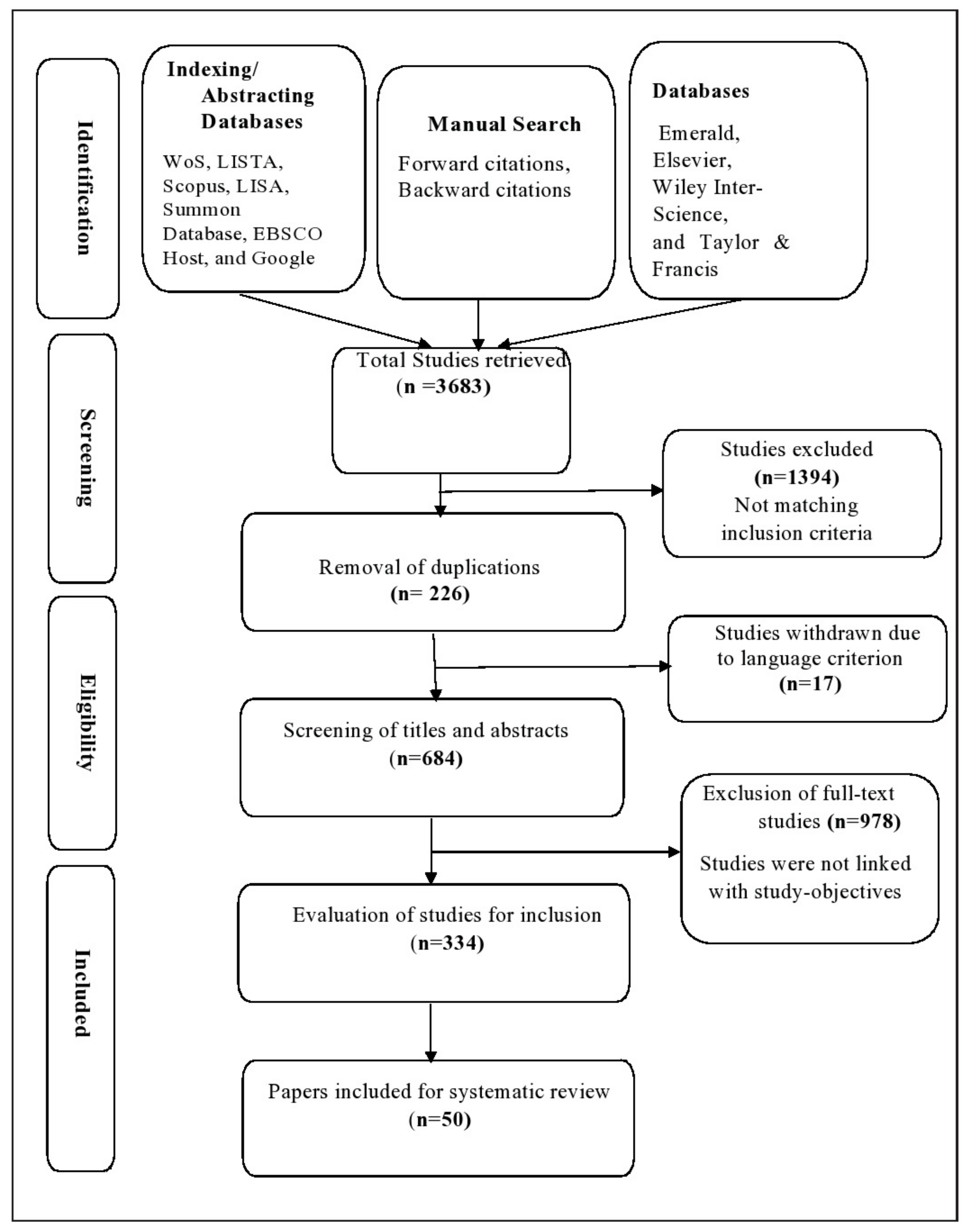
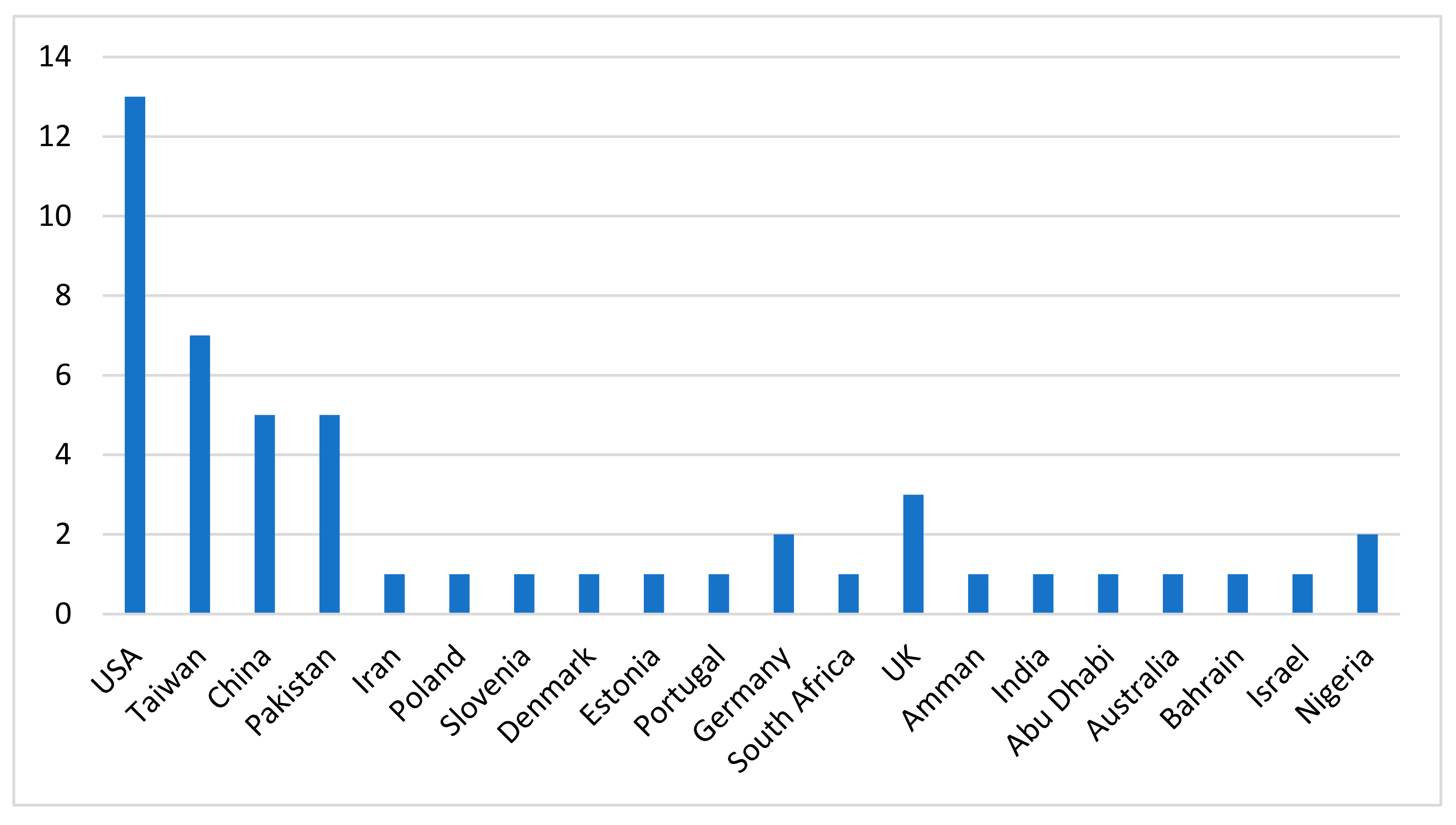

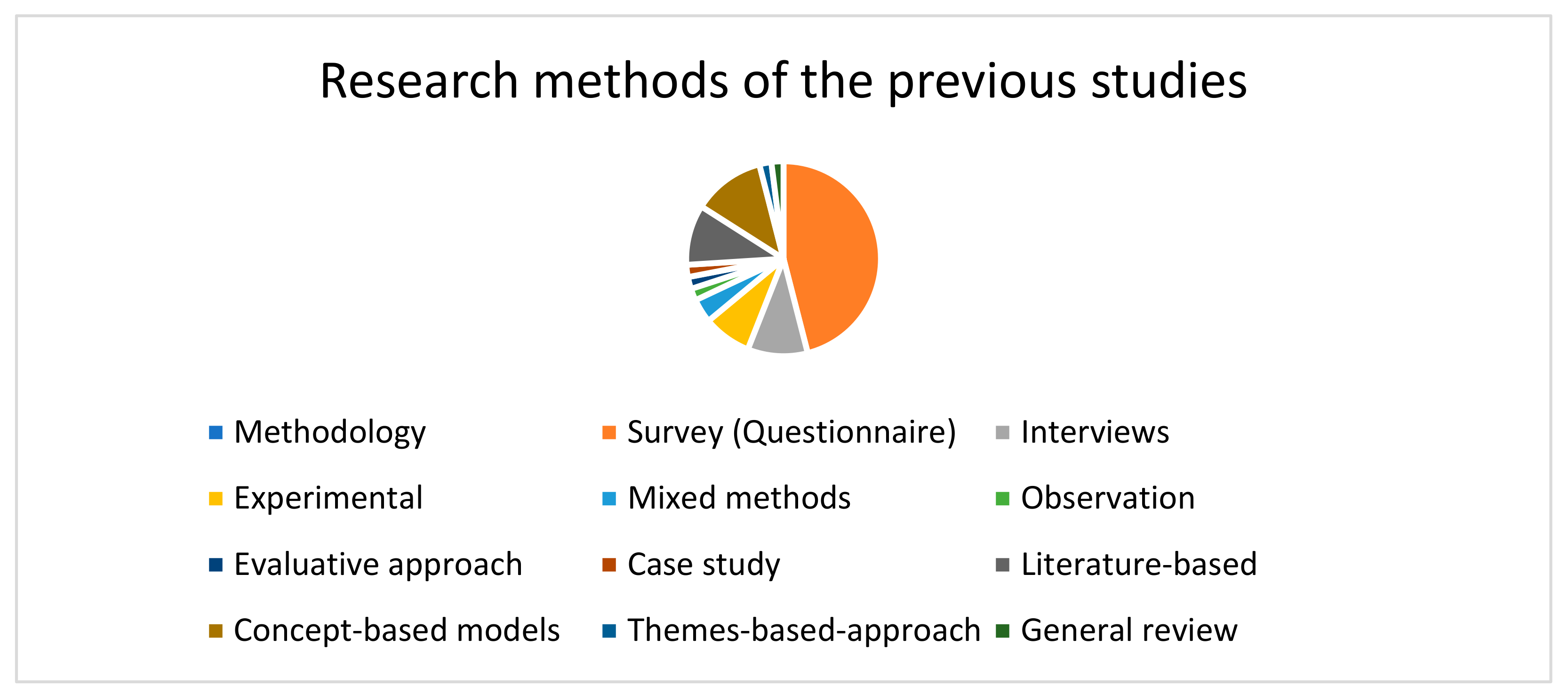
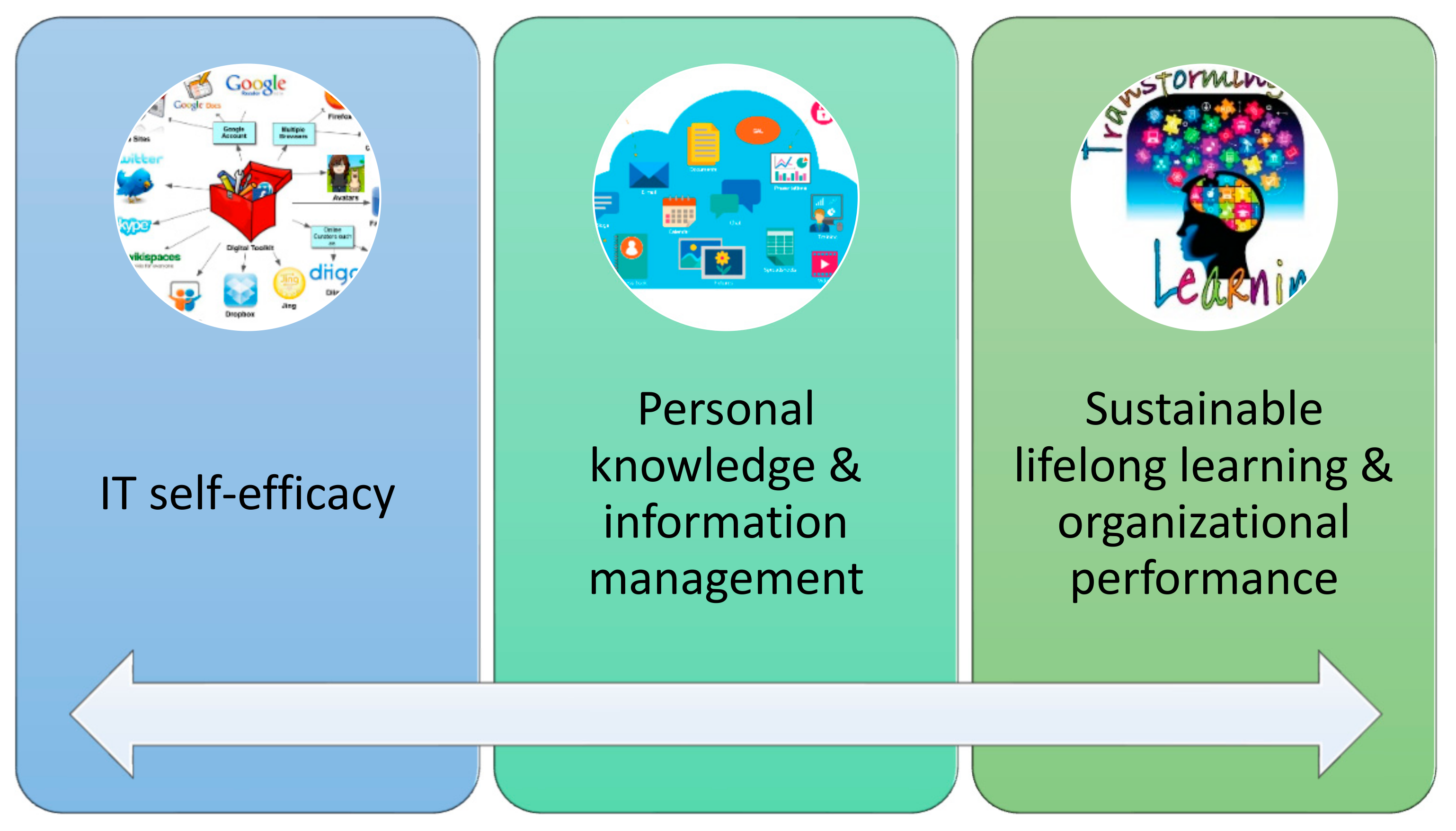
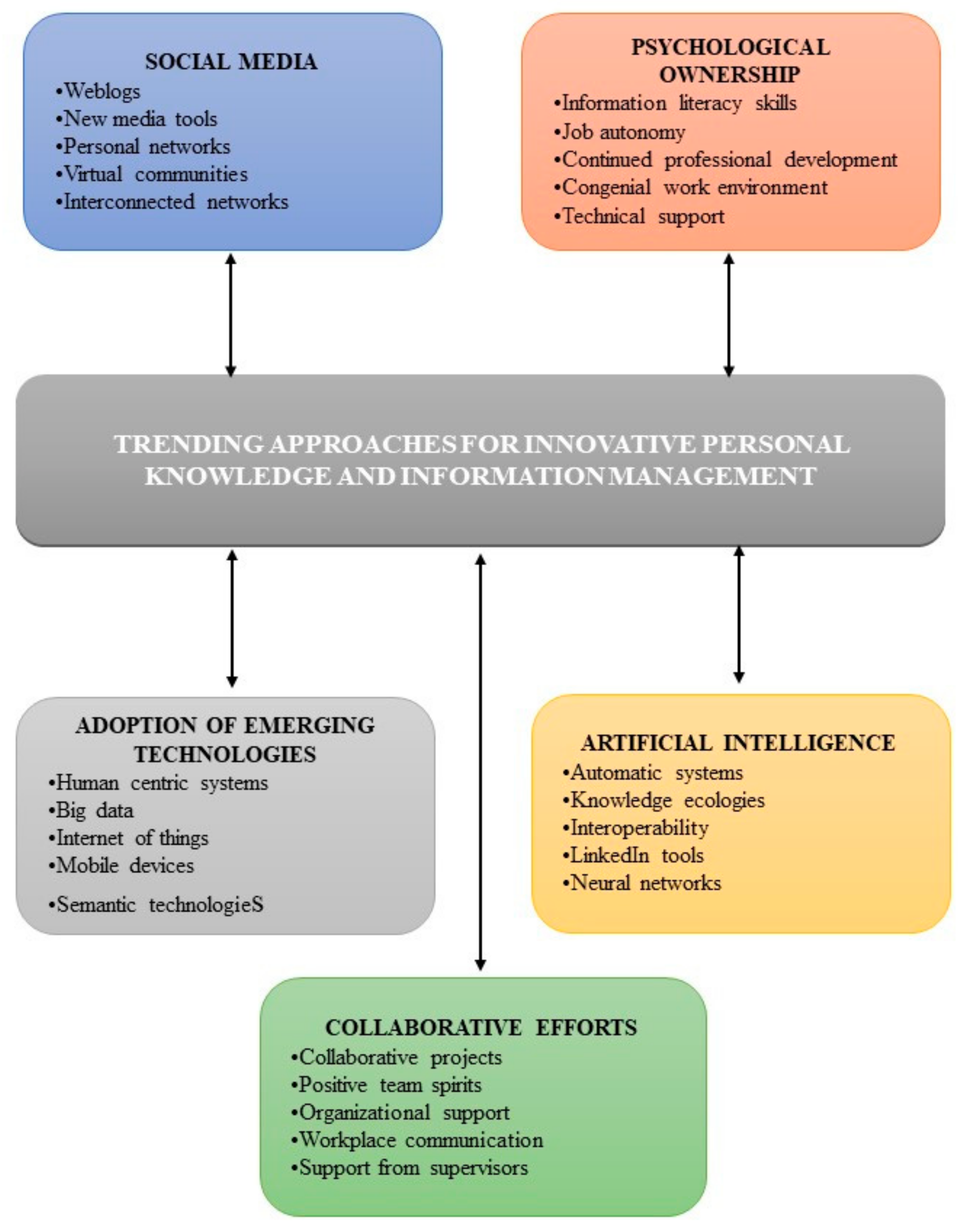
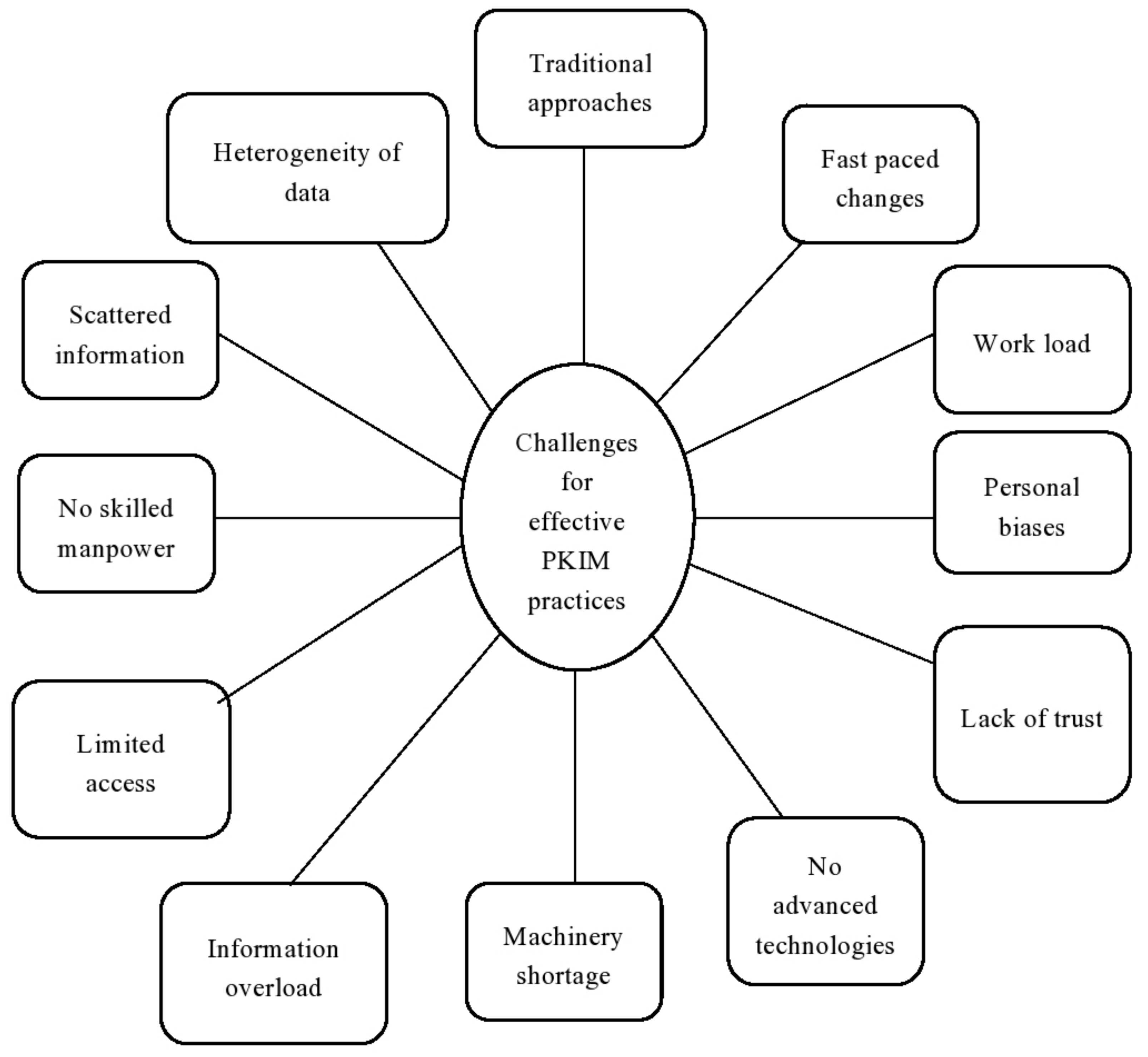

| Inclusion Criteria | Exclusion Criteria | |
|---|---|---|
| A | Research papers published in the English language | Papers published in other languages |
| B | Articles addressing the study’s objectives | Articles not covering the study’s objectives |
| C | Papers published from 2000 to 2022 | Papers published before 2000 |
| D | Articles matching with the study’s variables | Articles not meeting with the study’s variables |
| E | Only research papers published in peer-reviewed journals of the world’s leading databases | Conference proceedings, books, newspaper articles, dissertations, magazines, institutional reports, etc. |
Disclaimer/Publisher’s Note: The statements, opinions and data contained in all publications are solely those of the individual author(s) and contributor(s) and not of MDPI and/or the editor(s). MDPI and/or the editor(s) disclaim responsibility for any injury to people or property resulting from any ideas, methods, instructions or products referred to in the content. |
© 2022 by the authors. Licensee MDPI, Basel, Switzerland. This article is an open access article distributed under the terms and conditions of the Creative Commons Attribution (CC BY) license (https://creativecommons.org/licenses/by/4.0/).
Share and Cite
Shahzad, K.; Javed, Y.; Khan, S.A.; Iqbal, A.; Hussain, I.; Jaweed, M.V. Relationship between IT Self-Efficacy and Personal Knowledge and Information Management for Sustainable Lifelong Learning and Organizational Performance: A Systematic Review from 2000 to 2022. Sustainability 2023, 15, 5. https://doi.org/10.3390/su15010005
Shahzad K, Javed Y, Khan SA, Iqbal A, Hussain I, Jaweed MV. Relationship between IT Self-Efficacy and Personal Knowledge and Information Management for Sustainable Lifelong Learning and Organizational Performance: A Systematic Review from 2000 to 2022. Sustainability. 2023; 15(1):5. https://doi.org/10.3390/su15010005
Chicago/Turabian StyleShahzad, Khurram, Yasir Javed, Shakeel Ahmad Khan, Abid Iqbal, Imran Hussain, and M. Vaseem Jaweed. 2023. "Relationship between IT Self-Efficacy and Personal Knowledge and Information Management for Sustainable Lifelong Learning and Organizational Performance: A Systematic Review from 2000 to 2022" Sustainability 15, no. 1: 5. https://doi.org/10.3390/su15010005
APA StyleShahzad, K., Javed, Y., Khan, S. A., Iqbal, A., Hussain, I., & Jaweed, M. V. (2023). Relationship between IT Self-Efficacy and Personal Knowledge and Information Management for Sustainable Lifelong Learning and Organizational Performance: A Systematic Review from 2000 to 2022. Sustainability, 15(1), 5. https://doi.org/10.3390/su15010005










